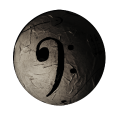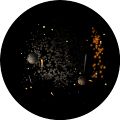Space between Sound
By Adam Newns
Intro
I want to follow in the heritage of FullDome, a development of the planetarium, which traditionally shows astronomical events.
I find this can be quite beautiful when combined with this particular piece by Liszt: File:Stück.mp3
This piece is done for the Werkmodul and will be roughly 2m 30s.
The Action
The music starts off gently, during which I hope to take the audience to the heavens, in which stars fly by and comets slowly appear and wane away. Large moons of music drift into the space and out of sight again.
As the music develops a mood of foreboding, the stars shy away and the moons turn dark. A large new moon of music makes its way overhead and explodes in a supernova with a crescendo in the music, releasing stars travelling towards the audience and energising the comets and a sun flies by, leaving a trail of firey energy. The pace increases but shortly dies away with the music.
The Technique
I was intrigued by the use of real footage in the dome, originally wanting to make the whole film out of just stop motion. However I had to compromise. Now the sun and moons are made with stop motion, so they rotate, revealing a piece of music as they go. The stars are not stop motion, but are actually photos created using matches, torches and mobile phones. However, I have added particles in After Effects and, in some cases, used a lot of effects on the footage. Obviously, all the motion is created in After Effects. However, I like the detail in the stop motion photography and the unnatural, jerky rhythm.
Technically I chose a planetary style, because I want to immerse the audience as much as possible by rendering the dome dark. In testing, I liked the darker films with small areas of colour and brightness and found the films where you are in an undefined space able to create a stronger sense of motion.
The Method
I started off wanting to do a film entirely with real images in a stop motion sequence, with one image the size of the whole screen. I was intrigued by the idea that images you used had to be distorted to be seen as normal in the dome, so I started taking pictures of spherical things. As I tested these ideas I decided the classic space-based content worked best in the dome, so I combined those two ideas into this music visualisation, including light based pictures - taking inspiration from light stop motion - because this looks like astronomical events and the contrast of a small area of bright colour on a dark background works best technically.
I made the balls with music on by coating balls of polystyrene in papier mâché, painting them, then drawing on actual music notation from the piece by Liszt I was originally going to use. When I was using this music, the ball rotated in time with the music, so it showed the notes as they were played. Now, however, the movement is a little smoother which I find suits this music better. I also photographed some other balls, one painted orange and one shaded grey. I only used the orange one, but animated both.
Material
Click here to see an animated comet
Hide and Seek
I am also doing the sound effects for 'Hide and Seek' by Andréanne Chartrand-Beaudry.
For this, I searched through sound libraries to get outside ambient tracks and some good quality bird sounds as well as recorded my own in a studio and combining them to create entirely different sounds, for example, birds fluttering out of trees from an umbrella. I synchronised and edited the sound effects in pro tools. Samples coming soon.





